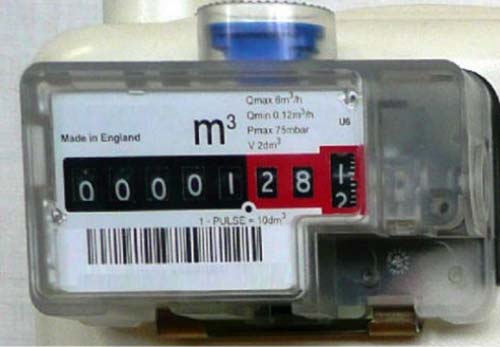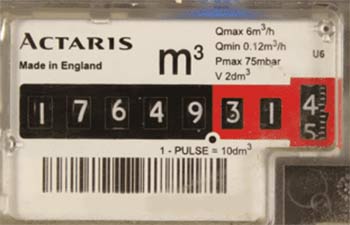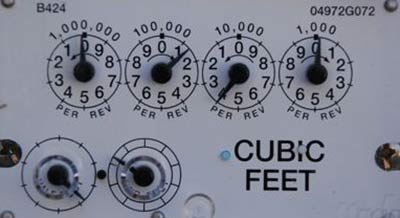A gas meter is installed when mains gas is supplied to a domestic or commercial property. The meter itself measures how much gas is used by the property so the gas supplier can bill for the usage accordingly.
As gas is pulled from the mains supply, the meter measures the volume that is drawn in cubic meters (³) or cubic feet and records and displays the usage via a set of dials on the front of the meter or as a read out on a screen if you have a smart meter.
In essence, to read your gas meter, you simply need to record the numbers that are displaying on the front of the meter and pass them on to your energy supplier, but as with most things, there are a few other things to consider also.
How to Read a Gas Meter
In general, reading a gas meter is very similar to reading an electric meter, but as we have discussed above, as opposed to being in kWh, the usage is stated as cubic meters or cubic feet (M³ or ft³), although it’s later stated as kWh on your bill.
One point to note with older imperial meters, they are measured in hundreds of cubic feet or 100 ft³, this isn’t always made apparent!
How you read your meter will very much depend on what type of meter you have:
Smart Gas Meter
If you have a smart meter in your home or have had any experience with smart meters you should be familiar with usage requirements.
If you don’t have a smart meter then one of the big bonus’s of having one is that you don’t need to submit any readings as the meter iself does that for you by feeding live updates directly to your supplier.

Smart meter showing gas usage – Image courtesy of British Gas
Digital Metric or Imperial Gas Meter
The digital or older imperial gas meter is arguably the most common type of gas meter found in UK homes and in terms of reading is pretty straightforward.
The first thing to do is establish exactly what type of meter you have.
If your meter only has 4 numbers to the left of any numbers in red then your meter is an older imperial-type meter.
If your meter has 5 numbers to the left of a decimal point or space then you have a newer-style metric meter.
In either case, to read your meter and provide your supplier with a meter reading simply note down the 4 (imperial meter) or 5 (metric meter) numbers to the left of any numbers in red, spaces or decimal points, reading them from left to right and adding them to your suppliers online meter reading facility of on the provided form if using a paper form.
Always include any “zero” values at the beginning.
Once submitted to your supplier they will then be able to issue with an accurate bill.

Numbered dials on the front of a digital gas meter showing meter reading – Image courtesy of gov.uk
Dial Gas Meter
If you don’t have the above digital metric or imperial-type meter, then the chances are that you have a dial gas meter.
If you’re not familiar with these types of meter then on first glance they can appear very confusing to read, but once you’ve got your head around how they work and what each dial is displaying, they’re fairly simple.
Here follows a few rules on how to read a dial gas meter:
- Read each dial from left to right, ignoring any dials in red, the large dial and also any that are marked up as “100 per rev”
- If the dial hand/pointer is resting between two numbers, always go with the lower number
- If the hand/pointer rests between 0 and 9, always go with 9
- After noting down your meter reading, if any of the numbers are stated as 9 you will need to take 1 away from the dial immediately to the left
- Pay attention to the way in which the numbers run around the face of the dial, some will run clockwise others counter-clockwise. Generally the first and third dials will run clockwise and the second and fourth will run counter-clockwise. Depending on which way they run, make sure you read the dial accordingly
If you follow the simple rules above then reading a dial meter is as easy as reading any other type of meter.
If you have read through all of the information and tips above, you should now be familiar with exactly how your supplier produces your gas bill, how you can work out your gas usage yourself and check your bills are accurate and also how to read all the common gas meters to get a reading.

Numbered dials on the front of a digital gas meter showing meter reading
Note: Gas is extremely dangerous so care must be taken when working around any gas appliances or supply pipes. To find out more about gas safety, see our project here.
Why do you Need to Supply Gas Meter Readings?
As briefly mentioned above, gas is supplied to a given property via the mains gas supply. A supply pipe is run from the main supply pipe up to the property where it is then connected to the meter.
A supply pipe is then taken from the meter into the property where it is then connected to any appliances that require gas to run.
As the gas is effectively piped straight into the property to be used, the meter is the only point of reference that a given energy company has to judge how much gas has been used and how much they should bill for, so by supplying them with a reading, this will ensure that you are billed only for what you have used.
In the event that an energy supplier is unable to get an accurate gas meter reading they will produce an estimate bill of what they think or project you have used.
This isn’t always ideal as depending on your past usage history (if you have any), the estimate could be wildly over or under what you have actually used, which in either case, isn’t ideal.
So, to avoid any undercharging or overcharging issues, it’s important that you update your supplier with regular, accurate readings.
In the event that you do not supply regular readings, your energy supplier will generally send around their own or contracted third party meter reader to take readings for the supplier.
If, however, you have a prepayment energy meter then you have to pay for both your gas and electricity upfront by purchasing credits. As you’re paying upfront then the need to supply regular readings for billing is not needed.
How is Gas usage Measured?
As briefly touched on above, gas usage is generally measured in either cubic meters (m3) or cubic feet (ft3) depending on the type of meter that is measuring the usage.
Generally, the older-type imperial gas meters measure in cubic feet and the newer digital metric meters measure usage in cubic meters.

Old type imperial gas meter measuring gas usage in cubic feet

Dials displaying meter reading on the front of a digital gas meter
Due to these very slight differences, the read out dials on each type of meter present the usage information slightly differently in that the metric meter displays part units as decimals and the imperial meter displays them in red and slightly separated from the full units used.
Although your meter measures usage in cubic meters or feet, if you have a look at your suppliers bill, you may notice that you’re actually billed in kWh.
This can be slightly confusing if you want to ever want to compare what your meter is telling you that you have used to what you have actually been billed for. To do this, you need to convert your cubic meters or feet usage into kWh which you can then multiply by the price you are buying from your supplier at to give you cost.
If you do want to work out your usage using your gas meter reading and supplier cost you will need:
- A copy of your most recent gas bill
- A copy of the gas bill prior to this
- A calculator
- A copy of the “Gas (Calculation of Thermal Energy) Regulations” for conversion factor reference
Most energy companies these days will detail on the actual bill how they have arrived at the stated charge, so it’s always a good idea to check this out first as it will give you a good idea of what gas you’ve used and what they’ve charged you for.
In the list above you may have noticed that we have mentioned the legislative regulations that govern the conversion factors used when calculating thermal energy, the “Gas (Calculation of Thermal Energy) Regulations (SI 1996/439).”
This legislation has been put in place to ensure that all companies that supply gas for sale use the same conversion and calorific factors in their calculations.
How to Calculate Your Gas Bill
If you want to calculate your own gas bill, follow the steps below. It’s also worth noting that the bill calculation method used by your given supplier may differ very slightly but the outcome should be pretty much the same.
Step 1 – Calculate Gas Used
Firstly, locate your previous gas meter reading and also your most recent reading. Subtract the figure of your previous meter reading from your most recent one to give you the volume of gas that you have used between the two billing periods.

Past gas meter reading found on previous gas bill
Step 2 – If you Have an Older Cubic FT Meter
If you have an older style imperial meter and your reading are in cubic feet then you will need to convert to cubic meters before going any further.
To convert from hundreds of cubic feet to cubic meters, the conversion factor is; 100 cubic feet = 2.83 cubic meters.
If your meter already measures usage volume in cubic meters, you can skip the above and move straight on to step 3 below.
Multiply your figure from step 1 by 2.83 to convert your reading to cubic meters.
Step 3 – Multiply by the Calorific Value of the Gas
Once you have your total usage figure in cubic meters, the next job is to multiply this figure by the gases calorific value.
The calorific value of gas is a gauge of the heat energy that’s contained within it. The calorific value of the gas that has been supplied to you should be stated on your bill. Once you have located it, multiply the previous figure by this value.
One thing to be aware of is that any gas supplied should fall between 38 mega joules per cubic meter and 41 mega joules per cubic meter. Anything more or less can cause serious issues with many gas-powered appliances.
One point to note is that the calorific value figure stated on your bill will most probably be an average figure of the quality of gas supplied to you over the given billing period
Step 4 – Account for Temperature and Pressure
By its very nature, gas expands and contracts due to temperature and pressure changes so these also have to be accounted for.
To do this, multiply the figure you arrived at above by 1.02264 (this figure is stated in the regulations linked to above, just in case you wondering how we arrived at it).
Step 5 – Convert to kWh
The penultimate task is now to finally obtain our kWh figure. To do this, divide the figure you arrived at above by 3.6.
as with the above, this division figure is also stated in the regulations linked to above.
Step 6 – Calculate Cost
As we have now finally obtained our usage figure in kWh, the last job is to now multiply this figure by the kWh unit cost that your supplier should state on your bill.
Once done, you should now have a total cost for kWh of gas that you have used for this given billing period. Compare your calculated cost to the one on your bill, do they match? If not, contact your gas supply company to discuss any discrepancies.
What Types of Gas Meter are There?
Similarly to electric meters, there can be quite a few different types of gas meter and the particular meter that is used for a given property will very much depend on its age.
In some cases if your meter is particularly old you energy supply company may choose to renew it. If this is the case then they will contact you with date and time of when they have either one of their own or contracted Gas Safe (information on Gas Safety and Gas Safe engineers can be found in our project here) engineers in your area to undertake the work.
One point to note is that over the years, some home owners that have had meters changed have has issues with billing after the meter change has been carried out.
Most of these issues are due to the fact that the readings from the old meters are not recorded correctly before the old meter is removed and the new one installed. Thankfully, these issues are now few and far between, but to be on the safe side, always take a photo of the reading on the old meter before it’s removed so that you have evidence of the reading just in case any issues arise.
In terms of the main different types of gas meter, they are as follows:
Standard Traditional Gas Meter (Imperial and Metric)
These types of meter are arguably the most common types of gas meter, found in hundreds of thousands of home across the country.
They generally come in two different types; either metric or imperial, with metric generally having five main numbers and imperial having only four main numbers.
A metric gas meter will also feature a decimal point to the right of the main numbers that states the part units that have been used.
Likewise, imperial meters will also state the part units that have been used, but instead of featuring after a decimal point, there will either be a slight space between the main numbers and part units, they will displayed slightly smaller or also possibly in red.
In terms of the actual display itself, the standard meter utilizes dials that rotate to display a number as gas is drawn through the meter.

Standard newer style digital gas meter

Old type imperial gas meter
Dial Gas Meter
As with dial-display electric meters, dial display gas meters are often seen as a little more complex than their standard gas meter counterparts.
Traditionally, dial gas meters were used before the emergence of the more common standard meters, so if your property is fairly old, chances are that you may have one.
If you have never seen one before, on first glance they do look fairly complex, but once you understand them, they’re pretty basic to use.

Older dial-type gas meter – Image courtesy of thegreenage.co.uk
Smart Gas Meter
As with the case of smart electric meters, smart gas meters allow you to view your gas usage in real time as the various gas appliances in your home use it.
As you can physically view the gas that’s being used in your home at any given time, this it a fantastic way of seeing what appliances are the worst offenders for gas use and allow you to reduce their use, which is much kinder on the environment and better on your pocket!
Where is my Gas Meter?
As with electric meters, gas meters are normally located either outside the property somewhere near to the front door or on the inside.
With most modern houses, the gas meter is normally located in a meter cupboard or box just outside the front door, but in some older houses, the gas meter could be in numerous locations.
In general, your gas meter should be in one of the following locations:
- In the meter box or cupboard outside the property
- Just inside the property near the back door
- In an under-stairs cupboard
- In a porch
- In the garage
- Maybe obscured from view by boxing in carried out by previous owners/tenants
In a lot of cases, gas meters are usually located on the outside of a property as this ensures that your gas supplier can easily access the meter to take their own readings.
Also, one final point to note is that on the odd occasion, the original installation location of a gas meter can indeed be changed. For example, if a gas meter is located in a garage adjoining the property and the garage is changed to a bedroom, the meter itself may still be in there.
So although a bedroom may seem like an odd location for a gas meter, bear in mind that the room currently housing your gas meter may not have always been used for that same purpose.
If after looking you are still unable to locate your gas meter there is still a few things you can do.
If you are in rented accommodation then your tenancy agreement should state it’s whereabouts. Failing this, your next port of call should be your landlord or letting agent.
If you have just purchased the property then the estate agent or previous owner should be able to guide you in the right direction.

Gas meter located in meter cupboard outside of property – Image courtesy of cablejoints.co.uk

